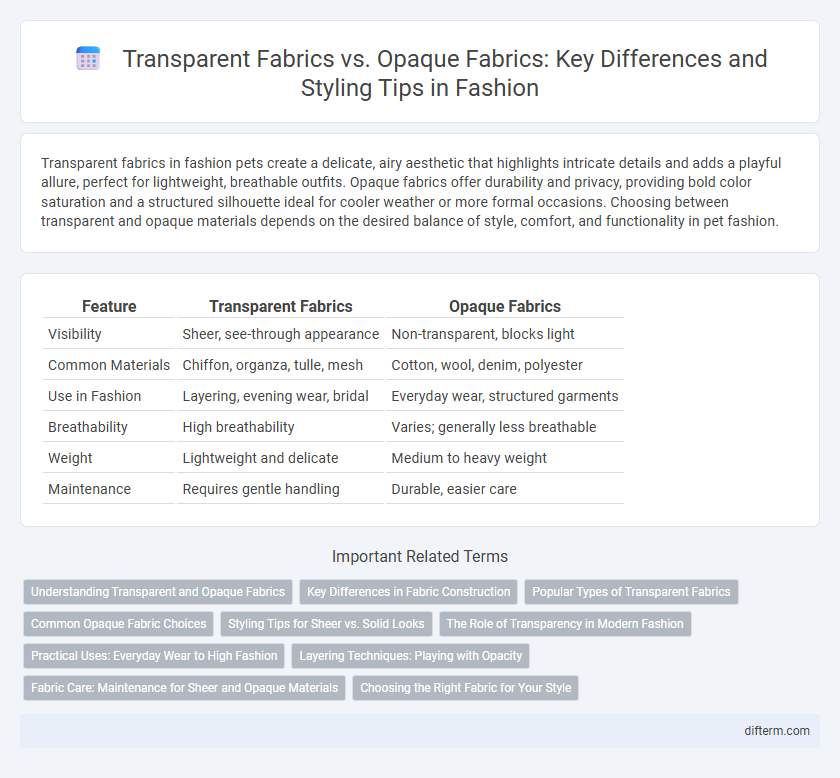Transparent fabrics in fashion pets create a delicate, airy aesthetic that highlights intricate details and adds a playful allure, perfect for lightweight, breathable outfits. Opaque fabrics offer durability and privacy, providing bold color saturation and a structured silhouette ideal for cooler weather or more formal occasions. Choosing between transparent and opaque materials depends on the desired balance of style, comfort, and functionality in pet fashion.
Table of Comparison
| Feature | Transparent Fabrics | Opaque Fabrics |
|---|---|---|
| Visibility | Sheer, see-through appearance | Non-transparent, blocks light |
| Common Materials | Chiffon, organza, tulle, mesh | Cotton, wool, denim, polyester |
| Use in Fashion | Layering, evening wear, bridal | Everyday wear, structured garments |
| Breathability | High breathability | Varies; generally less breathable |
| Weight | Lightweight and delicate | Medium to heavy weight |
| Maintenance | Requires gentle handling | Durable, easier care |
Understanding Transparent and Opaque Fabrics
Transparent fabrics such as chiffon, organza, and tulle allow light to pass through, creating an airy, lightweight appearance ideal for layering and delicate designs. Opaque fabrics like cotton, wool, and denim block light, providing more coverage and structure, making them suitable for everyday wear and tailored garments. Choosing between transparent and opaque fabrics depends on desired aesthetic, function, and comfort, influencing garment breathability, texture, and visual impact.
Key Differences in Fabric Construction
Transparent fabrics feature open weaves or lightweight fibers such as chiffon, organza, and tulle, allowing light to pass through and creating a sheer appearance. Opaque fabrics use tightly woven or knit fibers like cotton, wool, or denim, blocking light and providing full coverage. The key differences in fabric construction involve fiber density, weave tightness, and the thickness of yarns used, directly impacting transparency and durability.
Popular Types of Transparent Fabrics
Popular types of transparent fabrics include chiffon, organza, and tulle, each offering varying degrees of sheerness ideal for layering and elegant design. Chiffon provides a lightweight, flowing texture perfect for eveningwear, while organza boasts a stiffer structure suited for voluminous silhouettes. Tulle is widely used in bridal gowns and tutus due to its fine netting that creates delicate, airy effects without sacrificing durability.
Common Opaque Fabric Choices
Common opaque fabric choices in fashion include cotton, denim, wool, and polyester, each offering distinct textures and durability suitable for various clothing styles. Cotton provides breathability and comfort for everyday wear, while denim is favored for its sturdiness and casual appeal. Wool stands out for its insulation properties in colder climates, and polyester is known for its wrinkle resistance and versatility in both casual and formal garments.
Styling Tips for Sheer vs. Solid Looks
Sheer fabric styling thrives when layered over bold, solid colors or intricate patterns to create depth and visual interest without compromising modesty, making it ideal for eveningwear and sophisticated casual looks. Opaque fabrics offer versatility and coverage, serving as a reliable base for structured silhouettes and statement accessories that define polished, classic outfits. Combining sheer and opaque materials in a single ensemble enhances texture contrast and dimensionality, elevating everyday attire into effortlessly chic and fashion-forward statements.
The Role of Transparency in Modern Fashion
Transparent fabrics redefine modern fashion by emphasizing lightness, layering, and visual intrigue, allowing designers to play with contrasts and textures. Opaque fabrics offer durability, structure, and modesty, creating solid silhouettes essential for classic and functional styles. The strategic combination of transparency and opacity enhances depth and dynamism in contemporary clothing designs, appealing to diverse aesthetic preferences and occasions.
Practical Uses: Everyday Wear to High Fashion
Transparent fabrics such as chiffon and organza are popular in high fashion for creating ethereal silhouettes and layering effects, offering visual intrigue without bulk. Opaque fabrics like cotton, wool, and denim provide practicality for everyday wear through durability, coverage, and comfort, making them ideal for casual and work environments. Designers often combine these materials to balance style and functionality, ensuring garments meet both aesthetic and practical demands.
Layering Techniques: Playing with Opacity
Transparent fabrics like chiffon and organza offer versatile layering options that create depth and visual interest by allowing underlying textures and colors to subtly show through. In contrast, opaque fabrics such as cotton and wool provide solid coverage, making them ideal for structured layers that anchor an outfit. Combining these materials enables designers to play with opacity, balancing sheer and solid elements to craft dynamic and sophisticated looks.
Fabric Care: Maintenance for Sheer and Opaque Materials
Transparent fabrics, such as chiffon, organza, and tulle, require delicate handling during washing and storage to prevent snagging and maintain their lightweight structure. Opaque fabrics like cotton, denim, and wool demand more robust care routines, including proper drying techniques and stain treatments to preserve fabric density and color vibrancy. Understanding fabric composition and following specific care labels ensures longevity and maintains the aesthetic quality of both sheer and opaque materials in fashion garments.
Choosing the Right Fabric for Your Style
Transparent fabrics like chiffon, organza, and tulle create an airy, delicate look ideal for layering and adding subtle sensuality, while opaque fabrics such as cotton, denim, and wool provide structure, coverage, and versatility for everyday wear. Selecting the right fabric depends on the occasion, desired level of modesty, and personal aesthetic, balancing transparency with comfort and style. Incorporate transparent fabrics for eveningwear or statement pieces, and opt for opaque materials in casual or professional settings to ensure practicality and confidence.
Transparent fabrics vs opaque fabrics Infographic

 difterm.com
difterm.com